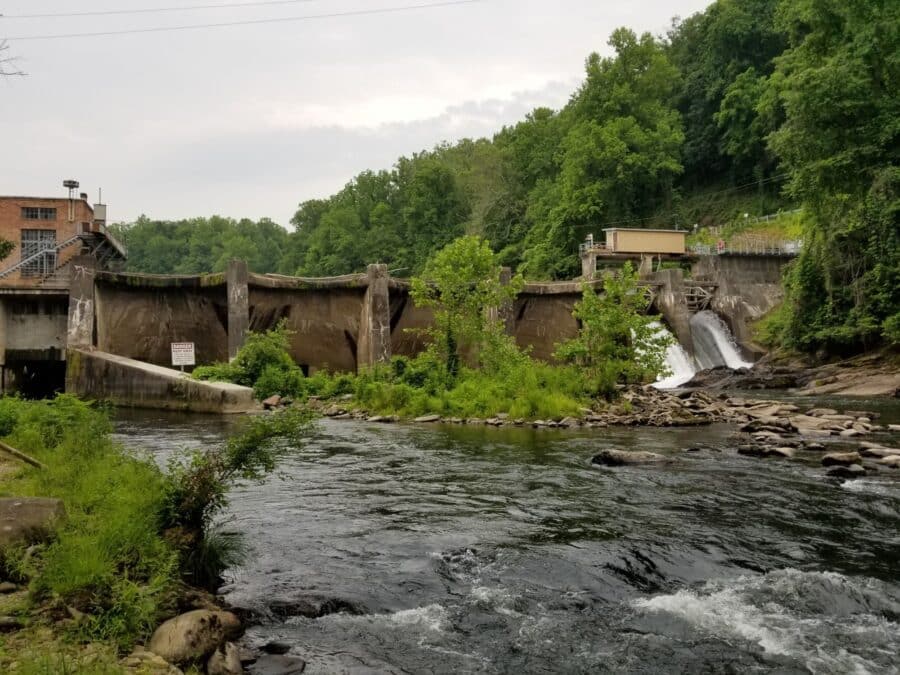A habitat disrupted
Joey Owle, the secretary of agriculture and natural resources for the Eastern Band of Cherokee Indians, takes a broader perspective. Standing on an observation platform downstream from the dam, he thinks back to the many centuries when the Oconaluftee, the main river flowing through Cherokee lands, faced no obstacle on its course to the Tuckasegee River.
Back then, the two rivers formed a unified habitat for species like the sicklefin redhorse, historically an important food fish for the Cherokee, and the vulnerable eastern hellbender, the continent’s biggest salamander. But the construction of the Ela Dam fragmented that habitat, breaking off 549 miles of the Oconaluftee watershed from the Tuckasegee.
Redhorse from the Oconaluftee who fall over the dam have no way back upstream to spawn, making it hard for the Cherokee to maintain a healthy population of the fish. And because the fish carries the larvae of the endangered Appalachian elktoe mussel, that species is also declining throughout tribal lands. Soon after joining tribal government in 2017, Owle says, he floated the idea of removing the dam as a way to restore the ecosystem.
“It was a joke—it wasn’t realistic,” Owle quickly clarifies. Although old and unproductive compared to most modern power plants, the dam was still an active hydropower asset, and it had been approved by the Federal Energy Regulatory Commission in 2011 to operate through 2041. Some tribe members and environmental advocates had grumbled about the dam’s ecological impacts during the FERC recertification process, Owle says, but there hadn’t been a real community movement on the issue.
In 2021, two things changed over the span of a couple months. That October, Northbrook Carolina Hydro II, the dam’s owner, accidentally released a huge plume of sediment into the Oconaluftee, destroying riverbed habitat for many species and landing the company in trouble with FERC. And in November, Congress passed the Infrastructure Investment and Jobs Act (IIJA), which allocated $200 million toward dam removals and other projects that improve fish habitats.
Owle sensed that a new deal might be possible, with Northbrook potentially tearing down the dam—which only nets about $55,000 per year—to avoid expensive repairs and compliance measures.
After initial talks with the U.S. Fish and Wildlife Service (USFWS), he reached out to the dam’s ownership himself. “I love search engines: I found a direct number to Chuck [Ahlrichs, president of the dam’s parent company],” he recalls with a laugh.
That call led to further discussions, and by February, the Cherokee Tribal Council had unanimously agreed to pursue dam removal together with Northbrook, nonprofit groups and federal authorities. In May, the coalition received a $4 million IIJA grant from the USFWS, and Owle is confident that the remainder of the project’s $10 million price tag will be covered by the state of North Carolina, the U.S. Army Corps of Engineers and other partners.
Learning Opportunities
Removing unwanted dams can bring many benefits to the environment and local communities. The N.C. Aquatic Connectivity Team, a collaboration of government and nonprofit groups focused on dam removal in the state, notes that free-flowing rivers are generally more resilient to flooding, safer for recreation and cleaner in water quality. Dam reservoirs may also produce methane, a gas that contributes to climate change, due to buildups of decaying organic material.
And there are plenty of opportunities to put dam removal into practice across the Southeast. The Southeast Aquatic Resources Partnership has inventoried nearly 344,000 dams throughout the region; the U.S. Environmental Protection Agency estimates that 75%-90% of those dams “no longer serve a functional purpose.” Yet just over 2,000 dams have been removed across the entire country since 1912, according to the national nonprofit American Rivers.
Owle admits that discussions about removing the Ela Dam, which is still viable for electricity production, are somewhat different than those about tearing down obsolete structures. But he believes the project still has lessons to offer removal work in the region and beyond.
First is the need to dream big, even when an idea seems far-fetched at the time. Owle says he started thinking about dam removal more seriously in 2018, when he was asked to serve on an environmental justice and equity board convened by the N.C. Department of Environmental Quality.
He came to realize that the Ela Dam’s disproportionate impact on Cherokee lands made it an environmental justice issue, not just an ecological obstacle. Developing that extra argument for the project, Owle believes, made him a more effective advocate when circumstances shifted to make dam removal a possibility.
Owle also cites the crucial role of coalition building in advance of big projects. Prior to Northbrook’s 2021 sediment release, he says, the Cherokee had started to partner with American Rivers on the Honoring Long Man River Cleanup, a trash removal workday on the Oconaluftee. (The name references the tribe’s traditional personification of the river as a person, with his “head” in the mountains and “feet” in the sea.) That existing relationship let him bring the nonprofit onboard quickly to advise the removal effort.
Another partner on the dam project, Mainspring Conservation Trust, had previously helped the Cherokee acquire and protect hundreds of acres critical for the tribe’s water supply. The trust has agreed to own the Ela dam and about 60 acres of adjacent land during the removal—and with it, any liability if the process goes awry—before transferring the property back to the Cherokee. Jordan Smith, Mainspring’s executive director, says the arrangement is among the first of its kind in the country.
Smith says the trust had the time and resources to explore the complex legal situation, allowing other coalition members to focus on tasks like fundraising and communications. “This isn’t something that one organization could do, but we’re very fortunate to be working with a team of folks that has an array of experience and knowledge to contribute,” he says. “That provides a level of comfort for us that we need to move into something that’s new.”
Despite all the moving parts, Owle says, the tribe’s history with its partners gives him confidence as well. “Organizations are all made up of people, so it’s the people you’ve got to deal with. You’ve got to be upfront with each other, truthful and honest,” he explains. “And then, when you start to accomplish some projects together, you’re like, ‘OK, what’s the next project?’”
Looking ahead
Patrick Hunter echoes the value of forthright collaboration. As managing attorney of the nonprofit Southern Environmental Law Center’s Asheville office, he was engaged by American Rivers to help guide the dam removal coalition through the intricacies of federal law.
He praises Owle for seeking a mutually beneficial solution with Northbrook in the wake of the sediment release. “My instinct would often be, let’s hold the dam owner accountable, whether that’s through fines or something else. [Owle] took a different approach and called them up,” Hunter says. “And that really changed the trajectory of everything that happened after that point.”
The time is ripe for other communities to start having similar talks with their dam operators, Hunter adds. Many dams that were built before the country’s adoption of stronger environmental laws in the 1970s received licenses for 50 years, he says—meaning they’ll soon be coming under new regulatory scrutiny.
“I don’t want to suggest that hydropower is going anywhere or we’re about to start systematically dismantling dams,” Hunter clarifies. “But that’s just a trigger point to initiate these conversations.”
Back at Ela Dam, water rushing in the background, Owle muses on the region’s future. He imagines the sicklefin redhorse having free rein of the watershed, the course of the Oconaluftee returned to a channel he’s only seen in archival photographs from the Western Carolina University library. He envisions the dam’s value more than compensated for by a more resilient ecosystem, its power replaced by solar panels.

Daniel Walton Daniel Walton is a North Carolina-based journalist covering stories about the environment, sustainability and local politics. He is a contributing editor for Asheville's Mountain Xpress, and his work has also appeared in Civil Eats, Carolina Public Press, and the Asheville Citizen-Times.
Have thoughts or reactions to this or any other piece that you’d like to share? Send us a note with the Letter to the Editor form.
Want to republish this story? Check out our guide.










